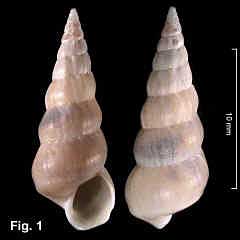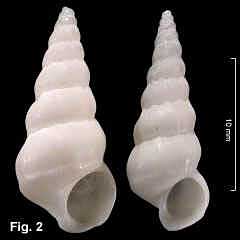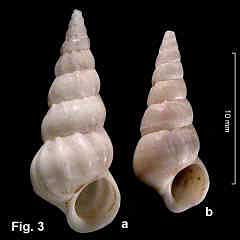|
|
|
|
|
Opalia ballinensis (E.A. Smith, 1891) Description: Shell tall, variable in height to width ratio (Fig. 2). Whorls rounded, sculptured with broad low axial ribs. Ribs aligned from whorl to whorl, variable in strength, usually absent on last whorl (Fig. 3); interspaces smooth or with faint spiral threads. Wide, low spiral rib at base, faint on weakly sculptured shells. Umbilicus closed. Aperture oval, outer lip thickened or not, expanded anteriorly. Colour white in worn shells, fawn in fresh specimens. Operculum corneous. Size: Up to 22 mm in length, commonly about 12 mm. Distribution: Endemic to Australia; Alexandra Heads, Queensland, southwards to Twofold Bay, NSW. Habitat: Presumably lives on rocky shores in the low intertidal and subtidal. Most specimens seen are from beach washup. Moderately common. Comparison: Opalia australis differs by having consistently strong and evenly spaced axial ribs on all whorls. O. granosa (Quoy & Gaimard, 1834), which occurs in southern Australia, from Malacoota in eastern Victoria westwards, is similar, but is a larger and wider shell with axials ribs more closely and regularly spaced and often restricted to the tops of the whorls. Synonymy: In early Australian literature O. ballinensis was considered to be the same species as O. granosa, but the differences in shell shape are consistent. Remarks: The macroscopic shell sculpture is variable. Shells vary from almost smooth (Fig. 3b) to strongly axially ribbed (Fig. 3a), the ribs being regularly or irregularly spaced. They are often strong and regularly spaced on early whorls, becoming weaker and irregular on latter whorls. The intritacalx (a chalky shell surface layer present in shells of the genus Opalia) is thick and relatively hard in shells of this species, often only being worn away on the early spire whorls (Fig. 2). Without magnification the intritacalx surface appears smooth, but at 50x magnification a rectangular pattern of minute pits is visible. Fig. 1: Typical specimen. Woody Head, Iluka, NSW. (C.339184) Fig. 2: Variation in shape. Ulladulla, NSW (C.339349 both specimens) Fig. 3: (a) Strong sculpture. Twofold Bay, NSW (C.007757) (b) Weak sculpture. Ballina, NSW (C.339186) |


